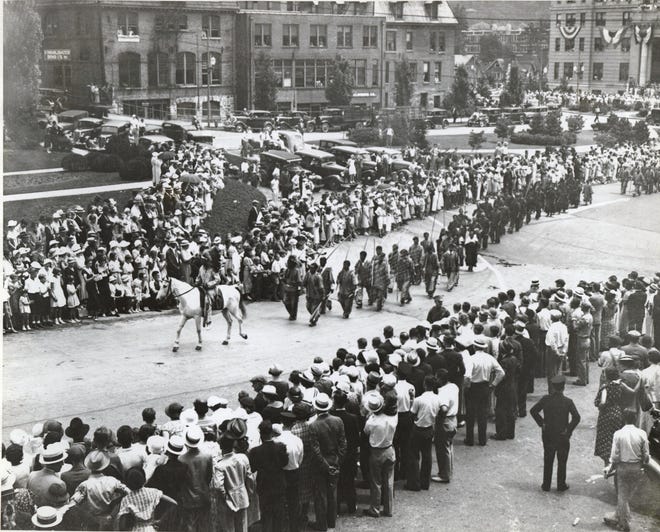
“The South’s greatest play-time in the world’s finest playground,” full-page ads announced in the 1930s about Asheville’s five-day Rhododendron Festival, a mountain Mardi Gras that attracted performers from 10 states and the attention of the world.
When Myra Peyton Lynch was named queen of the festival in 1934, her image appeared on front pages of newspapers from Boston to Texarkana.
“The Pathe news came and took movies of the pageant,” Lynch said. “I received letters from all over the country from people who had seen it.”
The festival, held the second week in June, reserved the third day for a parade of floral floats.
“Every summer, I went to stay with my aunt in Skyland,” said Cricket Williams, of Canton. “She had a flower and dairy farm and needed my help. She loved parades and every year we took a Greyhound bus downtown and watched the parade from in front of the S&W Cafeteria.
“I was named Cricket because I was small,” she said, “and I remember one man putting me on his shoulders so that I could see.”
Lynch was volunteering at the Junior League shop in the Grove Arcade when Festival committee members wandered by and offered her the queenship.
“I will have to ask my father,” Lynch said. Lynch’s father, Dr. James Madison Lynch, was a prominent surgeon. It was the Depression, and the Rhododendron Queen would have to undergo many expenses, including fancy dresses.
Lynch’s royal dress was supplied by the Chamber of Commerce. For the gown she wore to the Rhododendron Ball on the fourth night, she borrowed a train from her family friends, the Westfeldts of New Orleans and Rugby Grange (in Skyland).
The train was made of heavy silver net with each of the rows pleated with cellophane ruffles and lined with rhinestones.

The fifth night of the festival erupted with Pandemonium. A mutt dog parade. The King and Queen of Mirth, and their Grotesques. Fireworks. Dances!
At the end of each night, Lynch and her royal king, Grove Seely, dissolved their marriage, and Lynch partied with her fiancé, Stewart Rogers (the future architect).
“My husband,” Lynch said, “came out of Duke and Harvard and went to an interview with an architect in New York. ‘My advice to you,’ the architect said, ‘is, if you have a home, go to it.’ He did. His first job was measuring sewer and water lines in Asheville. It was a good experience.”
“The Depression was hard, but it was the great leveler,” said Lenoir Henry Swicegood, Asheville’s first drum majorette in 1934, and a participant in the Rhododendron Parade.
“Hardly anybody had a car. Whoever had one never went anywhere without six people in it, and there you were in your best evening dress, sitting in somebody’s lap.”
“It was the best of times.” Swicegood said.
In 1934, Swicegood went to David Millard Junior High School, as Asheville High had closed down temporarily for lack of funds. Educators did double duty; the school engaged volunteers. Joe Dinardo, a local drum and bugle corps leader, instantly transformed the ragtag elements of the high school band into a marching band.
Swicegood played trombone, the legacy of a shortage of violins when she had gone to make her choice in seventh grade.
“The trombone players marched in front,” she explained, “and maybe some people saw me and decided to give me a baton.”
Marching at football games and in the Rhododendron Festival and Christmas parades formed a fraction of Swicegood’s busy social life.
She and other teens went to Friday dances at the Vanderbilt Hotel, featuring bands such as The Buccaneers; pep club-sponsored dances in the Kenilworth Inn and on the roof of the Grove Arcade; DeMolay dances at the Masonic Temple; and, when flush, productions at the Hendersonville High School gymnasium, showcasing headliners such as Kay Kaiser.
Swicegood was in the thick of it. She earned money working the candy counter at Kress’ Department Store, serving the high school kids who took the streetcar home (25 cents), with a transfer that allowed them to get off at Pritchard Park for a downtown promenade.

Rob Neufeld wrote the weekly “Visiting Our Past” column for the Citizen Times until his death in 2019. This column originally was published June 4, 2012.